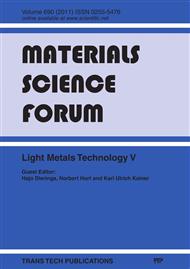p.413
p.417
p.422
p.429
p.433
p.439
p.443
p.447
p.451
Study on the Characteristic and Effect of the Nickel Ferrite Spinel Cermet as Al Electrolysis Inert Anode
Abstract:
Inert anode or non-consume anode possesses more advantages than traditional carbon anode in Al electrolysis. Because it does not consume during electrolysis, the inert anode can maintain its dimension; and this will led to the Al electrolysis easy to operate and administrate. Especially, the inert anode does not emit the carbon dioxide during the Al production, owing to its not consuming, and this has made the inert anode become one of the highlights in Al electrolysis industry. Unfortunately, up till now, there is no any material can endure the erosion of cryolite molten salt, keep its good electrolytic conductivity and be agreeable in price. In this paper, a cermet material composed of 85% nickel ferrite spinel and 15% metallic Ag has been studied, aim at exploring a kind of material which can be used as Al electrolysis inert anode. The works mainly focus on improving the boundary and microstructure between the metallic Ag and the nickel ferrite spinel interface. The practice test of this cermet material being used as Al electrolysis anode has been done in small laboratory scale, and its effect is quite better. We can draw the conclusion that the characteristic such as the conductivity, corrosion resistance and hot shock property of the cermet material can be greatly improved to meet the requirement of Al electrolysis by means of optimizing the spinel/metal interface, and once we settle the technique of fabricating this kind of anode to enough dimension, can we use this kind of material as inert anode in Al electrolysis industry to reduce the gas emission of carbon dioxide.
Info:
Periodical:
Pages:
433-436
Citation:
Online since:
June 2011
Authors:
Price:
Сopyright:
© 2011 Trans Tech Publications Ltd. All Rights Reserved
Share:
Citation:


